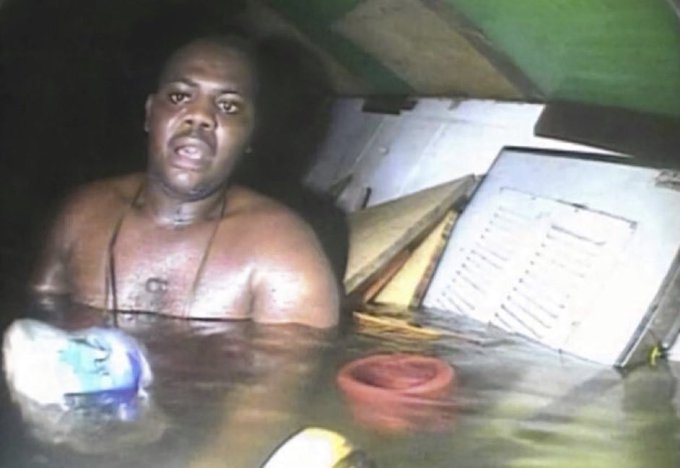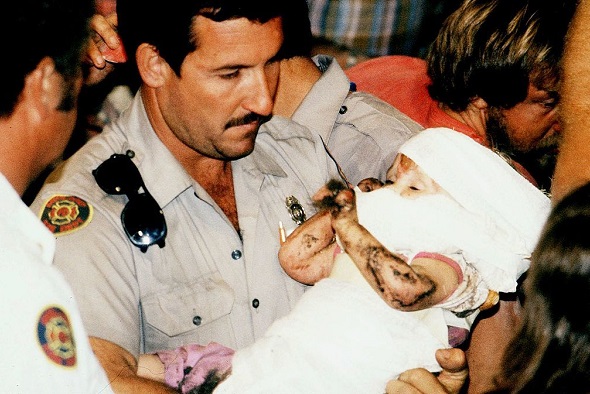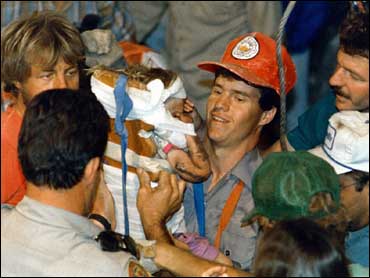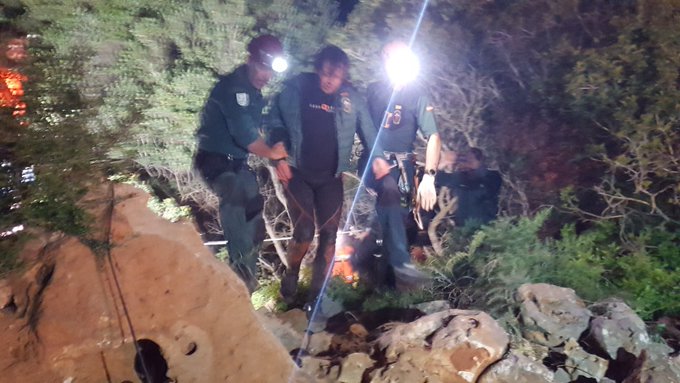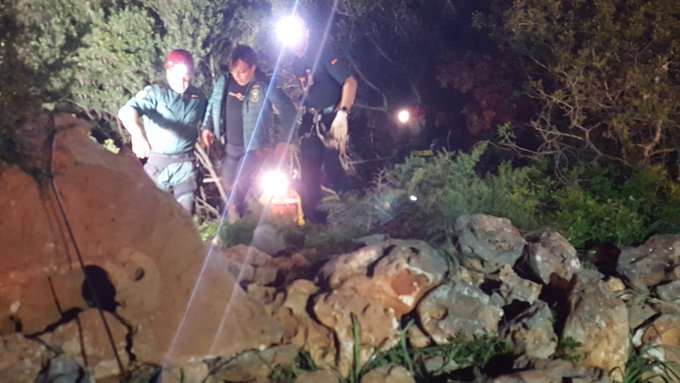A good action-survival film involving somebody getting trapped in a life-or-death situation can certainly get your heart pumping, but at least you get to escape that stressful movie world once it’s over. Unfortunately, that’s not always the case for everyone, as, once in a while, terrifying tales of people getting hopelessly stuck in tight, deadly spots occur in real life. From people getting trapped below a slab of ice in a freezing Alaskan river, to the man who spent sixty hours stuck at the bottom of the sea with his oxygen rapidly running out, here are some of the most horrifying claustrophobic true stories ever!
Harrison Okene: Surviving 3 Days Under The Ocean
On any normal night, waking up to go to the toilet is pretty irritating. But in May 2013, the call of nature actually saved the life of 29-year-old Harrison Odjegba Okene. Harrison, a cook on one of three tugboats towing a Chevron oil tanker off the coast of Nigeria, woke up at 5 AM and left his room to go to the shared bathroom at the end of the corridor. As he entered the bathroom, however, a giant wave capsized the boat, causing it to sink.
His fellow crew struggled to evacuate, as they were obliged to locked themselves in their rooms due to protocols protecting against pirates. Sadly, those safety measures only left them trapped, but because Harrison was already out when the ship capsized, he alone was able to escape. At least, he tried to. As soon as he stepped into the corridor, a strong gush of water swept him into another bathroom with an air pocket. Harrison clung to an overturned basin to keep his head above water, while the ship continued to plummet nearly 100 feet to the bottom of the ocean.

Rescue divers were immediately on the scene, but being unprepared for such a deep dive, they ended up retreating without ever reaching the wreck. And so, of the 12 crewmembers onboard, only Harrison managed to evade the sea’s powerful clutches, not that his sole survival was much of a comfort. After spending nearly a day in the bathroom, an exhausted Harrison decided to take his fate into his own hands, and swam through the pitch-blackness to the nearby engineer’s office. There, he stumbled upon another air pocket, only this time, he could actually stand on his feet. Harrison pried paneling off the wall and fastened it to a floating mattress to make a platform, allowing him some rest, though his hunger and thirst remained increasingly insufferable. Meanwhile, a dive support vessel, the Lewek Toucan, had deployed a deep-sea diving team to retrieve the crew. As they slowly made their way onboard, the last thing they expected was to have a hand reach out and touch one of the divers. Or, more specifically, the hand of someone still living. Especially since, according to scientists, Harrison’s 216 cubic feet air pocket was only supposed to have enough oxygen to survive for two-and-a-half days, and he had been down there for three!
When the divers found him, Harrison was unknowingly suffering from Caisson Disease, a condition in which nitrogen bubbles form in the blood, due to the drastic changes in pressure he’d experienced as the vessel sunk. If the divers were to bring Harrison directly to the surface, these bubbles could disrupt his vital functions, potentially proving fatal. So, to retrieve him safely, Harrison was taken up little-by-little in a diving bell, followed by being placed in a decompression chamber for two more days.
Once he re-surfaced for good, aside from suffering from post-traumatic stress disorder and feelings of guilt for being the sole survivor,
Harrison made a full recovery. He returned to his hometown of Warri in Nigeria, and vowed to never set foot on, or in, the sea again. He did snag another job as a cook, but, given the unbelievable ordeal he went through, we doubt you’ll see him whipping up something from the seafood section!
Tham Luang Cave Rescue
One day in June 2018, a youth soccer team called The Wild Boars from a rural village in the Mae Sai district of Thailand ended practice with a wholesome tradition. They ventured to the nearby Tham Luang cave, where new team members traditionally journeyed to write their names on a wall inside.

The twelve boys, together with their assistant coach, ventured in, brimming with excitement. Little did they know, however, that their innocent trip would soon take an unbelievably horrific turn. When evening came, and none of the Wild Boars had returned home, their families headed straight for the cave. As soon as the families saw the team’s bikes by the entrance, they raised alarm with the authorities, and rightly so! Deep inside the cave, the Wild Boars had run into some trouble. A sudden downpour of monsoon rain had caused a flash-flood, and the entire cave was rapidly filling up. So, with the entrance rendered inaccessible, the group had no other choice but to scramble deeper inside, eventually finding themselves marooned on a small, rocky shelf an astounding 2.5 miles from the entrance.

There, they huddled together to keep warm, and their assistant coach, a former monk, even taught them meditation techniques to use less energy. Luckily, despite their lack of food, the Wild Boars did have drinkable water in the form of moisture on the walls. But even that couldn’t still their biggest fear: whether anyone was coming to save them.Fortunately, a full-blown rescue operation was quickly unfolding outside. The Thai Navy Seals, National Police, and local volunteers all pitched in, but despite engineers trying to pump water out of the cave, the rising floodwaters made it near impossible to get inside. Five days later, the first international rescue team from all over the world, including the United Kingdom, Belgium, and Australia, arrived on the scene. They fought hard against the elements, not only having to maneuver themselves through tight, unreliable spaces, but also doing it under dark and impossibly-murky conditions. Eventually, just over a week after the incident, the divers reached a cavern which looked perfect for a key base, as it could be drained to a walkable level.

From there, two divers decided to journey on by themselves. They were swimming blindly through the cave, when they suddenly happened upon an air pocket. And just as they took of their masks,
they saw them: all thirteen Wild Boars, tired and hungry, but alive! The divers did the only thing they could, and left some lights with the team before promising to return with food. And just like that, a seemingly-hopeless search turned into a rescue mission. The Wild Boards were joined by a military medic, who prescribed them a special diet of nutritious, calorie-dense liquid food, and mineral water with added vitamins.
Regaining their strength was crucial, seeing as the hardest part was yet to come. Not only did rescuers have to extract 13 people from a cave even professional divers struggled in, but on top of that, the oxygen levels in the chamber had fallen from 21% to 15%. Time was running out, and rescuers only had limited options available to them. They either had to risk diving with the boys, or wait for the monsoon waters to recede, which sometimes took up to four months! After thoroughly practicing extraction training methods with local boys in swimming pools nearby, to make sure such an endeavor was even possible, nearly 100 Thai and foreign divers got ready for action.With guide ropes put in place, each Wild Boar was attached to a professional diver, and given a diving mask with oxygen. Secured in stretchers guided by elaborate pulley systems, through water of varying depths, and across difficult cave terrain, one by one, the
Wild Boars were brought out of the cave. They were immediately given oxygen, and transported to a hospital in Chiang Rai, in northern Thailand, where they all recovered.
But before you think this story ends on a totally sweet note, brace yourself for something ridiculous. Since the incident, undoubtedly to the horror of the team’s heroic rescuers, local officials have been planning to convert the cave into a museum and tourist attraction. Thirteen young people nearly died, not to mention the two divers who sadly lost their lives in the rescue, and they’d like to send wide-eyed tourists in there for fun? Most of us will pass on that vacation hotspot.
The Rescue Of Baby Jessica McClure
On the morning of October 14th, 1987, 18-month-old Jessica McClure was running around her aunt’s backyard in Midland, Texas, when she was suddenly plunged into unthinkable terror. Jessica and four friends were being supervised by Jessica’s mother, Cissy, when Cissy briefly went inside to take a phone call, and Jessica took a tumble. Not onto the ground like a normal toddler, no, but straight down an 8-inch wide, 22-feet deep well!
No one knows exactly how it happened, seeing as Jessica’s aunt had covered the opening with a large rock, but there Jessica was, lodged in the well at a narrow point halfway to the bottom. As Cissy returned to the scene, her heart sank. There was nothing she could do except call for help and watch on in despair as rescuers spent the next 58 hours working fervently to free her toddler.
To keep the subterranean child alive, rescue teams installed heaters to blow warm air down the freezing-cold well, and lowered a microphone to monitor Jessica’s breathing. With the assistance of oil drillers, rescuers dug a 20-foot deep, 30-inch-wide hole parallel to the well. Then, using high-pressure water drill equipment, an engineer drilled a horizontal tunnel between the two wells, approximately two feet beneath the wedged-in Jessica.
Thankfully,
she was successfully freed shortly thereafter, and thoroughly examined. In the aftermath, Jessica unfortunately lost one of her toes due to complications from a loss of circulation, but aside from that, she made a full recovery. In fact, Jessica had no memory of being trapped in the well, and actually only found out when she was 5 years old, and saw herself on the TV show, Rescue 911. You can bet her parents had some serious explaining to do that night! Either way, it’s probably for the best she doesn’t remember, seeing as being wedged in an insanely-claustrophobic spot, not knowing what’s lurking in the pitch-black below you is about as nightmarish as it gets.
Alaskan Rafting Ordeal
In June 2003, 38-year-old Blake Stanfield surprised his father, Neil, with a rafting trip for his 65th birthday. The pair had always been close, and a trip down Koyukuk River in Alaska had forever been on their bucket list. So, on Friday the 6th of June, they were dropped off at the northern fork of the Koyukuk, the starting point for their week-long, 90-mile journey to the town of Bettles. Blake and Neil planned to take their time, hike the rugged terrain, and relax around campfires. Only, things didn’t turn out quite so idyllic.
A few hours after setting off in their cataraft, the men noticed sheets of ice clinging to both sides of the river. They didn’t pay much attention to it, seeing as, when they’d flown upriver to the drop-off zone earlier, nothing major had appeared to be blocking their path downstream. It was only when they rounded a bend and saw a river-wide shelf of ice obstructing their path, that Blake and his father started to panic. They tried to paddle upstream, but the current was too strong. In an instant, the boat slammed into the ice and flipped. The pair were pulled under the rock-hard slab, with ice scraping at their skin and only a thin layer of air offering quick breaths.

At one point, they popped into an opening, before the river dragged them under another slab, this time without any air pockets. At this point, Blake’s lungs were absolutely bursting. He couldn’t see his father, and couldn’t do anything to help. He thought they were about to die, but then, the ice suddenly cleared.Instinctively, Blake swam to the nearest bank. He ran down the shoreline after his father, who had latched onto a block of ice, and eventually managed to help him ashore with a branch. Bruised and shivering, all the men had left of their supplies were a lighter, a knife, two life vests, whistles, a map, and one pair of waders.

With the rest of their gear long-gone downstream, they trekked down the river until they found a dry gully with a fallen tree across it, the perfect skeleton for a shelter. Even with this rudimentary base, though, with six days left before the bush pilot expected them in Bettles, Blake began to grapple with the fact that they probably wouldn’t make it. At 65, Neil was weak and hypothermic, and was struggling to walk. Blake didn’t want to leave his father, but at 10:30 the next morning, he set out to find help. His journey, however, was anything but easy. Not only did the treacherous Alaskan terrain feel like walking on bowling balls, but Blake also had to watch out for grizzly bears, of which he luckily spotted one early enough to sneak past. After more than 12 hours of hiking, Blake stopped to rest for the night. Little did he know, however, Neil was having problems of his own. In the middle of the night, the unfortunate elder woke up to find the rudimentary campfire he’d established had somehow set his shelter on fire. Being unable to stop it, he had to helplessly watch on as the entire thing turned to ash.

Luckily, where one of the men suffered, the other gradually trudged towards success. When morning came, Blake reached an elevated region in the river. He could hear passing planes, but despite lighting a fire, no one noticed him. The men ended up spending five days apart without food or supplies, until, finally, a bush pilot spotted their raft on a bank, and lowered his plane to check it out. Blake, fortunately being in the same area, started waving his life vest, and at long last the pilot saw him. With nowhere to land, all the pilot could do was drop Blake some food and a radio, before heading in Blake’s father’s direction, where he was thankfully still alive. The park rescue service was immediately notified, and four hours later,
a helicopter retrieved the men from their respective positions. They were bruised, dirty, hungry, and freezing, but other than that, totally fine.
But if you thought this near-death experience was enough for both of them to quit rafting, you’re mistaken! Soon afterwards, Blake and Neil went back to Koyukuk River for a second round. Only, this time, they actually spent the trip together!
91 Year Old Locked In Bank Vault For 23h
In September 2013, a 91-year-old Frenchwoman from Rennes was out running her Saturday errands, when she popped into her nearest BNP-Paribas bank. After asking to see her safety deposit box, the bank employee led her into the vault and locked the door behind her, as was standard bank protocol. But what wasn’t bank protocol was having a brain fart of nuclear proportions and forgetting about the old lady for the rest of the day. Pretty bad, right?
Well, that wasn’t all: the same bank employee turned out the lights and left at the end of the day, without ever checking the soundproof vault. That poor
91-year-old was left trapped in a bank vault by herself, with no phone or method of communicating with the outside world!
But here’s the worst part: it was Saturday, meaning the bank wouldn’t reopen the next morning. That unfortunate soul was left facing the reality of having to sit there until Monday, in the dark, with the walls feeling as if they were closing in on her, and no evident source of fresh air.
Thankfully, the lady’s son became worried when he didn’t hear from her that Saturday evening, and ended up calling the police. After retracing the lady’s steps, and visiting all her favorite hotspots, they eventually wound up at the bank. But that alone didn’t achieve much. Despite making several frantic calls, the bank manager only arrived at 10 AM on the Sunday morning!
Luckily, aside from some dehydration, the old lady was in tip-top shape, although you doubt the same could be said about the bank employee after his manager was finished with him!
Cave Diver Rescued After 60 Hours Underground
In April 2017, geology teacher Xisco Gràcia slipped into the sparkling waters of Mallorca for a dive. He and his diving buddy, Guillem Mascaró, wanted to explore Sa Piqueta, a cave located along Mallorca’s eastern coast, with numerous submerged chambers stretching out from its entrance; perfect for cave-diving. They swam for nearly an hour underwater, delving almost a kilometer deep into the stalactite-ridden labyrinth.
At this point, while Xisco was collecting rock samples, Guillem ventured off to chart an even deeper chamber. All went well, until the time came for them to surface, and a horrifying realization dawned upon them. Their guideline, a nylon wire, had broken, and they couldn’t find it anywhere.
To make matters worse, their oxygen tanks were almost empty. Luckily, Xisco recalled hearing about an air pocket in a chamber nearby. He led Guillem to it, and there they quickly planned an exit route on their map. Unfortunately, they only had enough oxygen left for one of them to make it out, so Xisco told Guillem to go.Once he was alone, Xisco removed most of his equipment and explored the chamber. He quickly realized the water at the surface was drinkable, and also found a large, flat rock he could pull himself onto. While things initially seemed promising, after seven or eight hours of waiting, he grew concerned. Was Guillem dead? Did anyone know he was down there?
Even though he kept himself calm, the oxygen in his air pocket was rapidly-depleting, and Xisco soon fell prey to the effects of breathing in high levels of carbon dioxide. Aside from having a headache and being unable to sleep, Xisco was becoming delirious. He constantly thought he saw lights surfacing nearby, but every time he blinked, they were gone.

Eventually, Xisco heard a noise above him. It sounded like tanks being filled with air, and for a moment he thought his struggles were over. But then the noises stopped, and he realized it was just another hallucination. With hopelessness and asphyxiation washing over him equally, Xisco almost didn’t hear when another noise echoed nearby. And it wasn’t just a hallucination this time. A diver emerged from the water, and Xisco embraced him in unspeakable relief. As it turned out, the noises he’d heard weren’t hallucinations, but were in fact rescuers’ failed attempts to drill through the top of the cavern to supply him with food and water. When
Xisco finally emerged from the cave-complex, he was shocked to hear that he’d spent almost 60 hours in the chamber. As dire as that sounds, though, neither Xisco, nor Guillem, have since turned their backs on diving. In fact, just a month after the incident, Xisco went back to the chamber. In his eyes, he had already conquered it, and there was nothing more it could do to bring him down.
Burglar Found Dangling Over Deep Fat Fryer
It was a normal evening in March 2011, when general manager John Risko got a call from his boss, the owner of Paesan’s Pizza Place in Guilderland, New York, asking him to go over and check on the fire alarm that had been triggered. John didn’t expect much going over there, but once he got inside, he was shocked to discover a burglar in the restaurant. Only, instead of being scared, John burst out laughing. Why?
Because the burglar, 46-year-old Timothy Cipriani, was
wedged in a shaft above the stove, with only his legs dangling outside. Apparently, Timothy had climbed a tree onto the roof, and broke into the air duct. But when he tried to shimmy down, he well, got stuck, which is, of course, a claustrophobic’s worst nightmare.
However, in trying to free himself, Timothy ended up stepping on a pipe that forms part of the fire suppression system, causing it to burst and trigger the alarm. I mean, I don’t know which is worse: Being lodged half-way out of a dark, narrow airduct with no space to turn around and nothing to support your feet on, or actually trying to shimmy down it in the first place! Police on the scene had to spend 30 minutes freeing Timothy before they could arrest him.
And when they finally checked his record, they were amused to discover Timothy had been previously charged when he broke into another New York restaurant, El Rey Cuchifrito. That time, he’d been convicted after police found a towel at the scene which Timothy had used to clean himself up after cutting his leg on the window he broke in through! Honestly, there’s probably not much hope for this guy. While some criminal masterminds leave calling-cards, Timothy just leaves, well, himself.
The Nutty Putty Cave Rescue & the Death of John Jones
Over Thanksgiving in 2009, 26-year-old John Edward Jones, a medical student and experienced spelunker, in other words, a person who explores caves as a hobby, decided to go spelunking with a group of friends in Utah County, Utah.
On November 24th, the group ventured into the Nutty Putty Cave, a popular spelunking spot known for its incredible twists and turns. John decided to try and find the appropriately-named Birth Canal, a formation known for being outrageously narrow. Unfortunately, though John had squeezed himself down that tunnel when he was younger, he failed to realize the one he chose this time was actually a different, narrower tunnel. It all started off promising, with John wiggling forward using his hips, stomach, and fingers, but soon, he realized he was stuck, upside down, and without any room to turn around or go back.

Thoroughly wedged, John’s only option was to keep moving forward. So, he flattened his chest by exhaling, and slithered slightly further down the opening. But when he inevitably had to inhale again, his chest expanded, and he was stuck even worse than before. Can you imagine being lodged so tightly that you can’t even breathe in much more than a fraction of your lung capacity? John’s panic-levels must’ve been shooting through the roof! Especially when his brother failed at pulling him out by his calves, and ended up leaving him to find help.

Eventually, rescuers from the Utah County Sheriff's Office arrived, and began a complicated extraction attempt. They were able to partially free John by using a rope-pulley system, but at that point, John had been hanging upside down with limited breathing ability for more than eight hours. Out of necessity, he was given an IV drip, and, lifted into a very slightly wider crack, though still narrow enough to keep him stuck, even managed to speak to his wife over a police radio. Everyone seemed relieved, until disaster struck once more. An equipment failure caused the rope system to plunge John right back into the gap he’d been trapped in, and the rescue operation was back to square one.
Trying a different approach, rescuers used air-powered tools to chip away at some of the rock around John, but after more than 24 hours upside down, the pressure and stress on John’s body was simply too much.
John eventually became unresponsive, and soon after, a doctor confirmed John had left this mortal coil following cardiac arrest.
Rather than risk any further injury retrieving him, the decision was made to leave John in place, and concrete was poured into the tunnel as a memorial, while the cave entrance was boarded up. Of course, it’s not the happy ending we all would’ve liked, but it just shows the immense danger of ending up in horrifically claustrophobic situations. I hope you were not too terrified at these claustrophobic stories! Thanks for reading.






















